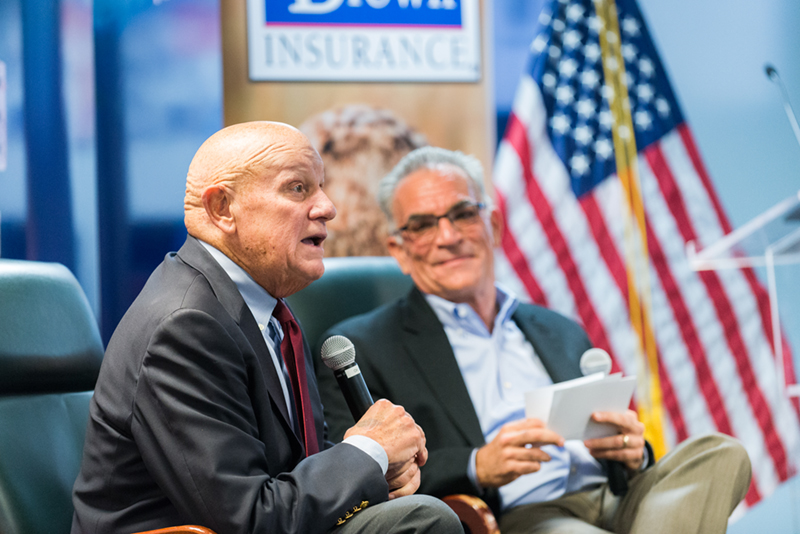Best-selling business book author shares his insight
George Labovitz is the founder and CEO of ODI, an international management training and consulting company. He also was a professor of management and organizational behavior at the Boston University School of Management, from which he recently retired. He counsels senior executives on organizational alignment strategies as well as quality and productivity management.
The Boston native has been published in the Wall Street Journal, Quality Progress and Quality Management in Healthcare. He is the co-author of “Making Quality Work” and lead author of the best-selling business book “The Power of Alignment.”
He has served as a consultant to the Navy and the Air Force. He holds a bachelor’s degree from Boston University, an MBA from Boston College, and a PhD from Ohio State University. Before his graduate studies, Labovitz was a captain and pilot in the Air Force.
He was interviewed by Stephen Garber, director of Third Level, for SFBW’s exclusive Veterans of Influence event at the Port of Palm Beach. The following transcript has been edited for brevity and clarity.
The Power of Alignment has been a best-selling business book for years, about to go into a second printing. What is alignment?
Let me first tell you where alignment came from. I’m an accidental entrepreneur. I started my company, creating a management training program for both health care and for industry. We were a management training company, rapidly growing, and, accidentally, we got into the quality improvement business.
We did business with Procter & Gamble, and FedEx has been a client of mine since 1989. My co-author and I noticed there was something going on in those companies that transcended process and improvement. Yes, they were doing something faster, cheaper, better. But there was something else going on. And we decided to call that something else “alignment.”
There are 30 years of empirical research, mostly from Harvard and the University of Southern California, a little bit from Boston University, that shows organizations that are aligned, integrated and focused outperform their competitors by every major financial measure.
And so I wrote a book to articulate what that extra something is. Alignment is when the critical elements of a business are working in concert with each other to drive growth and profit. In my view, they are organizational competencies. One of those are having a clearly articulated strategy for your business and being able to rapidly deploy it. The operative word being “rapid” because strategies change. And can you deploy it down to the people who have the skills and knowledge to execute it? Strategies are executed from the bottom of an organization, not the top.
If only 10 percent of the people in your organization really understand what you, the boss, are trying to accomplish, that is misalignment. You want clearly articulated strategies down to the people that can execute it. That is vertical alignment.
Vertical alignment is imperative in the military. This is some of the work that I did for five years when I helping the Navy. If you were an admiral about to take 9,000 young men and women into harm’s way, in a battle group, you would want to make sure that every department head, every manager knew exactly what the mission was and what they were going to contribute to that mission. That’s not enough. You also need horizontal alignment. You need to be customer-focused.
Over at Procter & Gamble, they were fanatical about understanding their customer base. Before the customers know what they want, P&G knew what they wanted.
What keeps you centered is leadership. And right underneath leadership is measurement. That old adage—you can’t manage if you can’t measure—is true.
Why did the chief of naval operations make it required reading for all of the 400 admirals in the Navy?
I found out that the biggest buyer of my book was the Navy, so I sent Chief of Naval Operations Vern Clark [who served 2000-05] a note: “Lots of luck with alignment.” Two weeks later I was invited to his office and met him in the Pentagon. That began my five-year hitch with the Navy.
The reason he made alignment the No. 1 goal for the Navy is because, in his business, second place is a terminal disease. In business, you lose a step in the market and shares goes down, nobody dies.
He explained to me why the Navy was such a candidate for organizational alignment. There’s an underwater Navy, there’s an aviation Navy, there’s a surface Navy, there’s an east coast Navy, there’s a west coast Navy. And none of them talk to each other. This guy transformed the Navy. Alignment was his model, his banner. And I was blessed to have the honor to work with him and be his agent.♦
About Veterans of Influence
SFBW’s Veterans of Influence series is an exclusive, invitation-only, quarterly event that brings together South Florida’s top business leaders to meet and mingle with their peers.
The evening begins with a cocktail reception for about 100 guests followed by a live interview of a C-level military veteran who provides insight into their personal lives, careers and views on issues affecting the business community.
The presenting sponsor is Brown & Brown Insurance and the gold sponsors are CenterState Bank and Port of Palm Beach.
Partnering with SFBW on this exclusive event provides an opportunity to network with the area’s business elite, generate new business opportunities, and increase brand awareness. For information about event sponsorship opportunities, email Clayton Idle at cidle@sfbwmag.com.




















